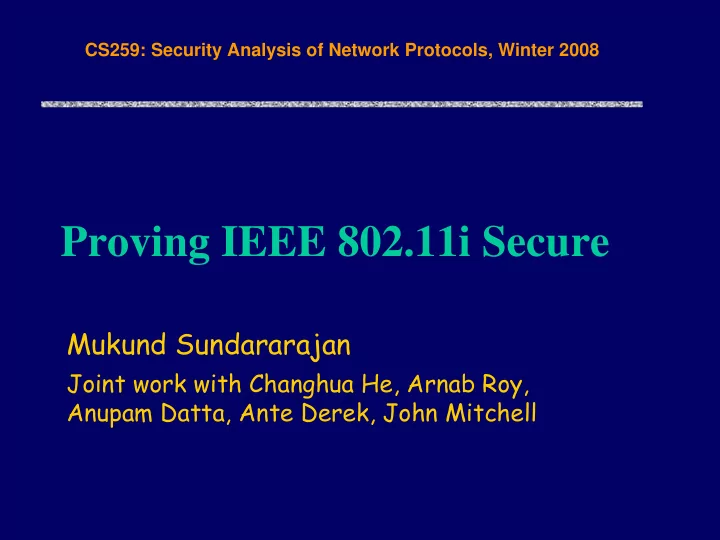

CS259: Security Analysis of Network Protocols, Winter 2008 Proving IEEE 802.11i Secure Mukund Sundararajan Joint work with Changhua He, Arnab Roy, Anupam Datta, Ante Derek, John Mitchell
802.11i Key Management Auth Laptop Access Server Point TLS: Uses Certificates, provides authentication (Shared Secret-PMK) 4WAY Handshake: Creates keys for data communication Group key handshake: Keys for broadcast communication Data protection: AES based
Properties of 802.11i Key Mgt. � Roughly • Only authorized devices can join n/w • Devices do not join rogue n/w • Peer device is alive • Keys set up for data and group communication are fresh and secret
Proof of 802.11i security A Formal Proof in Protocol Composition Logic (PCL) of : � On execution of an 802.11i role, properties listed in the standard are satisfied. � Attacker model (perfect crypto) • Intercept, read, reorder, delete any message on the n/w • Construct, send messages
Why a Proof? � [He Mitchell] analyzed 4Way Handshake using Murphi • Found a DoS attack • But did not find any security flaws � [Mitchell Shmatikov] analyzed TLS � ‘Finite’ state analysis does not guarantee security
Model Checking does’nt Scale Laptop A.P. A.S. EAP-TLS EAP-TLS Server Client 4WAY 4WAY Authenticator Supplicant Group key Group key Supplicant Authenticator 802.11i
TLS Server Role receive C, S, n c , suite C //Hello new n s send S, C, n s , suite S //Resp receive C, S, {sec} Ks , SIG C (hshk1) //Xfer check SIG C (hshk1) decrypt {sec} Ks send S, C, hash sec (hshk2) //ServerView
Security Properties of TLS � The client and the server agree on • Value of the secret • Version and crypto suite • Identities (mutual authentication) • Protocol completion status � The secret term is not known to a principal who is not the client or the server (shared secret)
Matching Conversations Honest(C) [TLS Server] S ∃ C. Send ( C, Hello) < Receive ( S, Hello ) ∧ Receive ( S, Hello ) < Send ( S, Resp) ∧ Send ( S, Resp) < Receive( C, Resp) ∧ Receive( C, Resp) < Send ( C, KeyXfer) ∧ Send ( C, KeyXfer) < Receive ( S, KeyXfer) ∧ Receive ( S, KeyXfer) < Send( S,ServerView)
Proof Sketch 1. S sees SIG C (hshk1) concludes C constructed it 4. If honest C constructed SIG C (hshk1), then it executed actions consistent with TLS Client role 5. Order actions based on freshness of nonces
Some Axioms Used in the Proof
Program Invariant used in Proof
Proof of TLS Authentication
Matching Conversations!
Proof Structure EAP-TLS Client EAP-TLS Server Pre-conditions 4WAY Local Authenticator Reasoning Program Based on actions Invariants And cryptography Group key Authenticator Group key 4WAY Supplicant Supplicant
Protocol Insights � 802.11i is secure � Other modes are safe • Using Cached PMKs and Pre-shared Keys is safe • Safe under error handling � Protocols can share certificates with TLS as long as conditions listed in paper are satisfied
Evolution of WLAN Security � Wired Equivalent Privacy • Incorrect use of cryptography • WEP lacks key mgt � 802.11i is designed to fix these issues (June 2004) � [He Mitchell] uncovers DoS attacks � Fix adopted by standards committee � Security Proof of 802.11i
Error Handling [HM05] Stage 1: Network and Security Capability Discovery Stage 2: 802.1X Authentication (mutual authentication, shared secret, cipher suite) 802.1X Failure Stage 3: Secure Association (management frames protected) Association Failure Stage 4: 4-Way Handshake (PMK confirmation, PTK derivation, and GTK distribution) 4-Way Handshake Timeout Stage 5: Group Key Handshake Group Key Handshake Timeout Stage 6: Secure Data Communications Michael MIC Failure or Other Security Failures
Interactions can cause Flaws � Exercise: Construct two protocols. Each does something reasonable. Each is secure in isolation. � But, if any principal executes both protocols, one of the two protocols is insecure. • Chosen protocol attack (Wagner et.al.)
Thanks!
Recommend
More recommend